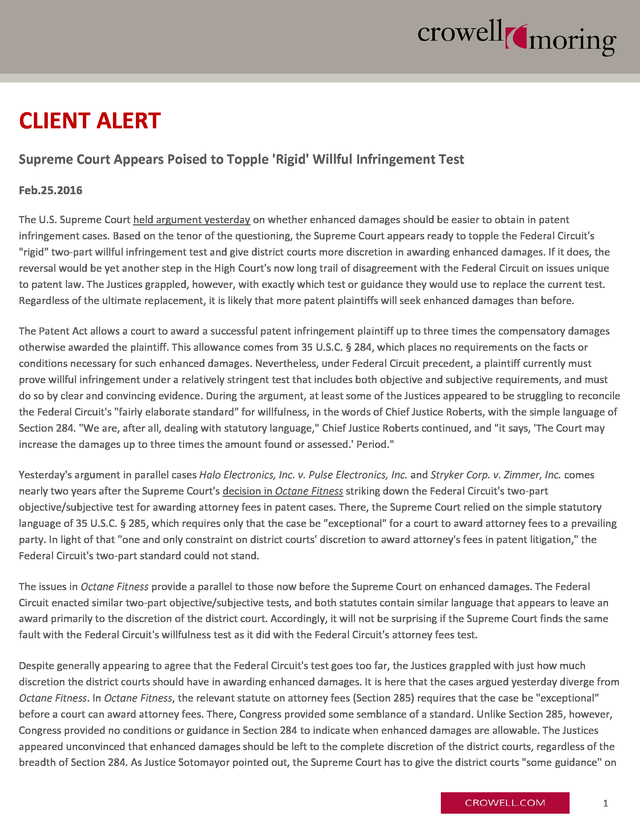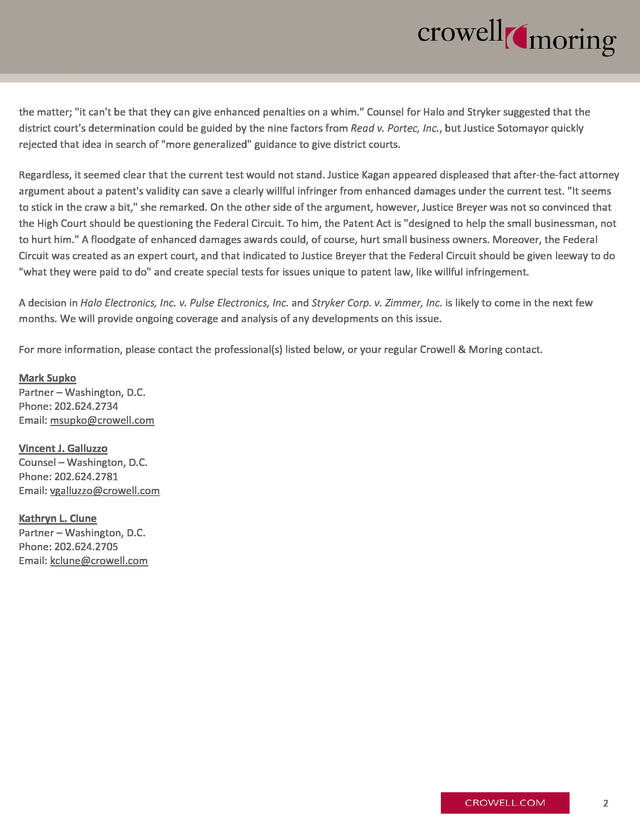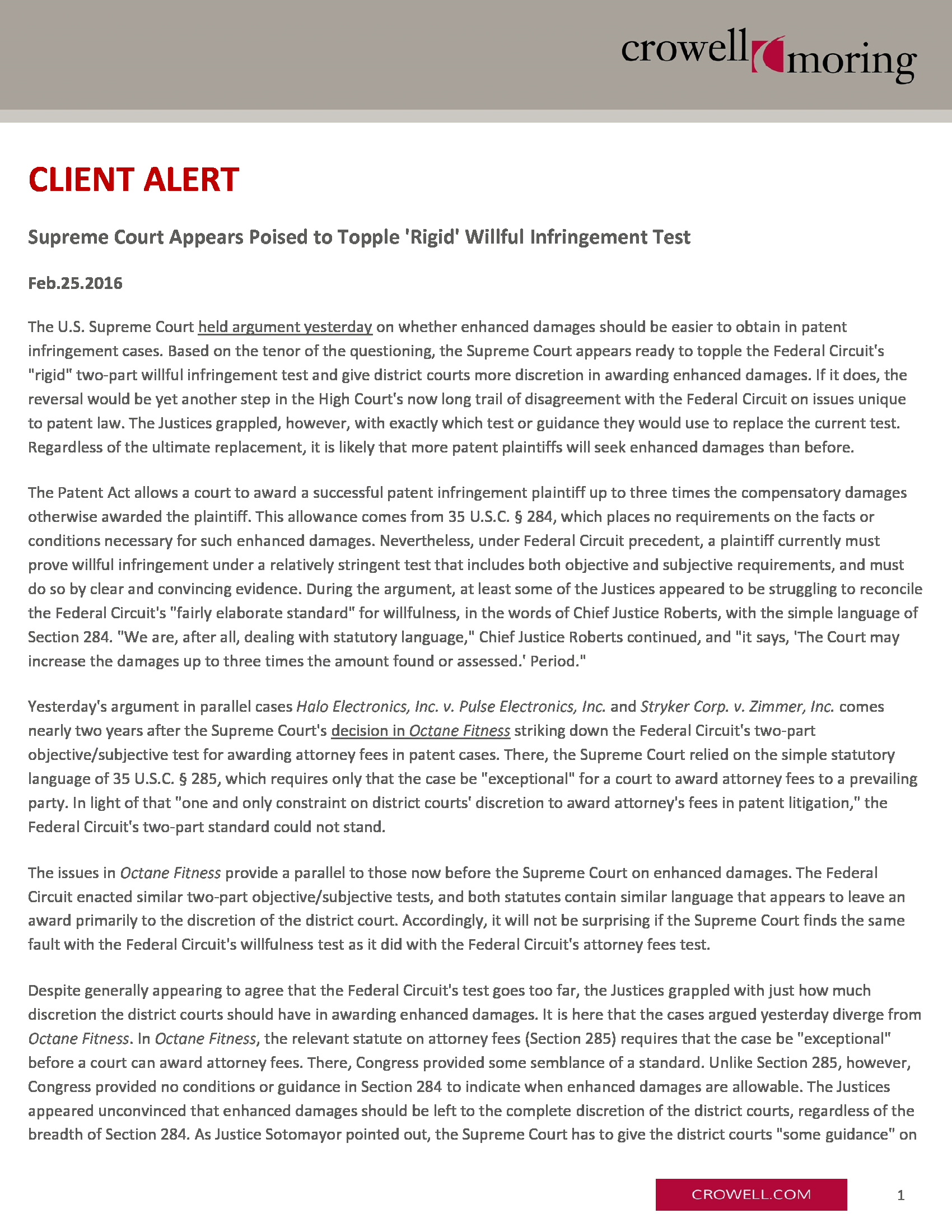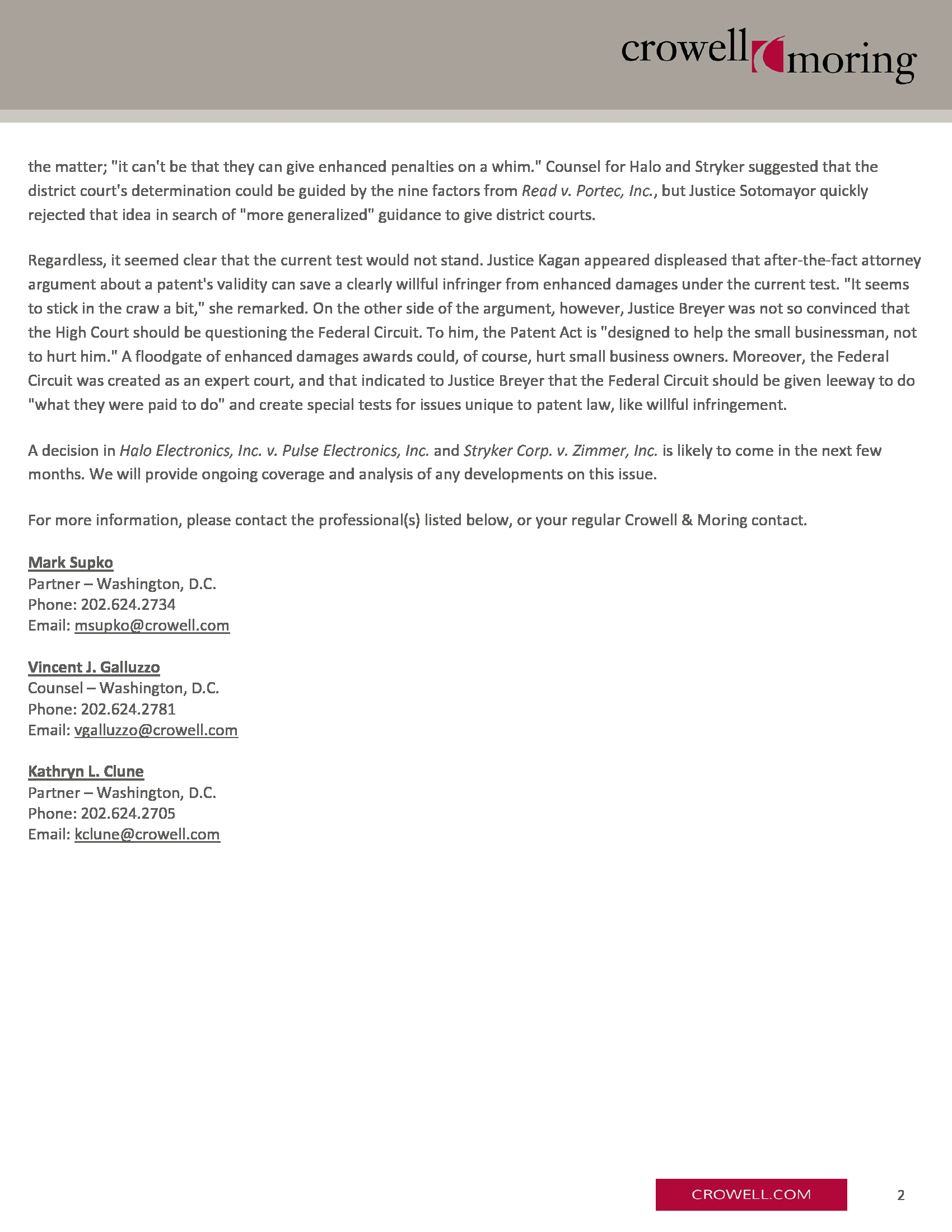Supreme Court Appears Poised to Topple 'Rigid' Willful Infringement Test – February 25, 2016
Crowell & Moring
Description
CLIENT ALERT
Supreme Court Appears Poised to Topple 'Rigid' Willful Infringement Test
Feb.25.2016
The U.S. Supreme Court held argument yesterday on whether enhanced damages should be easier to obtain in patent
infringement cases. Based on the tenor of the questioning, the Supreme Court appears ready to topple the Federal Circuit's
"rigid" two-part willful infringement test and give district courts more discretion in awarding enhanced damages. If it does, the
reversal would be yet another step in the High Court's now long trail of disagreement with the Federal Circuit on issues unique
to patent law.
The Justices grappled, however, with exactly which test or guidance they would use to replace the current test. Regardless of the ultimate replacement, it is likely that more patent plaintiffs will seek enhanced damages than before. The Patent Act allows a court to award a successful patent infringement plaintiff up to three times the compensatory damages otherwise awarded the plaintiff. This allowance comes from 35 U.S.C. § 284, which places no requirements on the facts or conditions necessary for such enhanced damages.
Nevertheless, under Federal Circuit precedent, a plaintiff currently must prove willful infringement under a relatively stringent test that includes both objective and subjective requirements, and must do so by clear and convincing evidence. During the argument, at least some of the Justices appeared to be struggling to reconcile the Federal Circuit's "fairly elaborate standard" for willfulness, in the words of Chief Justice Roberts, with the simple language of Section 284. "We are, after all, dealing with statutory language," Chief Justice Roberts continued, and "it says, 'The Court may increase the damages up to three times the amount found or assessed.' Period." Yesterday's argument in parallel cases Halo Electronics, Inc.
v. Pulse Electronics, Inc. and Stryker Corp.
v. Zimmer, Inc. comes nearly two years after the Supreme Court's decision in Octane Fitness striking down the Federal Circuit's two-part objective/subjective test for awarding attorney fees in patent cases.
There, the Supreme Court relied on the simple statutory language of 35 U.S.C. § 285, which requires only that the case be "exceptional" for a court to award attorney fees to a prevailing party. In light of that "one and only constraint on district courts' discretion to award attorney's fees in patent litigation," the Federal Circuit's two-part standard could not stand. The issues in Octane Fitness provide a parallel to those now before the Supreme Court on enhanced damages.
The Federal Circuit enacted similar two-part objective/subjective tests, and both statutes contain similar language that appears to leave an award primarily to the discretion of the district court. Accordingly, it will not be surprising if the Supreme Court finds the same fault with the Federal Circuit's willfulness test as it did with the Federal Circuit's attorney fees test. Despite generally appearing to agree that the Federal Circuit's test goes too far, the Justices grappled with just how much discretion the district courts should have in awarding enhanced damages. It is here that the cases argued yesterday diverge from Octane Fitness.
In Octane Fitness, the relevant statute on attorney fees (Section 285) requires that the case be "exceptional" before a court can award attorney fees. There, Congress provided some semblance of a standard. Unlike Section 285, however, Congress provided no conditions or guidance in Section 284 to indicate when enhanced damages are allowable.
The Justices appeared unconvinced that enhanced damages should be left to the complete discretion of the district courts, regardless of the breadth of Section 284. As Justice Sotomayor pointed out, the Supreme Court has to give the district courts "some guidance" on 1 . the matter; "it can't be that they can give enhanced penalties on a whim." Counsel for Halo and Stryker suggested that the district court's determination could be guided by the nine factors from Read v. Portec, Inc., but Justice Sotomayor quickly rejected that idea in search of "more generalized" guidance to give district courts. Regardless, it seemed clear that the current test would not stand. Justice Kagan appeared displeased that after-the-fact attorney argument about a patent's validity can save a clearly willful infringer from enhanced damages under the current test. "It seems to stick in the craw a bit," she remarked.
On the other side of the argument, however, Justice Breyer was not so convinced that the High Court should be questioning the Federal Circuit. To him, the Patent Act is "designed to help the small businessman, not to hurt him." A floodgate of enhanced damages awards could, of course, hurt small business owners. Moreover, the Federal Circuit was created as an expert court, and that indicated to Justice Breyer that the Federal Circuit should be given leeway to do "what they were paid to do" and create special tests for issues unique to patent law, like willful infringement. A decision in Halo Electronics, Inc.
v. Pulse Electronics, Inc. and Stryker Corp.
v. Zimmer, Inc. is likely to come in the next few months.
We will provide ongoing coverage and analysis of any developments on this issue. For more information, please contact the professional(s) listed below, or your regular Crowell & Moring contact. Mark Supko Partner – Washington, D.C. Phone: 202.624.2734 Email: msupko@crowell.com Vincent J. Galluzzo Counsel – Washington, D.C. Phone: 202.624.2781 Email: vgalluzzo@crowell.com Kathryn L. Clune Partner – Washington, D.C. Phone: 202.624.2705 Email: kclune@crowell.com 2 .
The Justices grappled, however, with exactly which test or guidance they would use to replace the current test. Regardless of the ultimate replacement, it is likely that more patent plaintiffs will seek enhanced damages than before. The Patent Act allows a court to award a successful patent infringement plaintiff up to three times the compensatory damages otherwise awarded the plaintiff. This allowance comes from 35 U.S.C. § 284, which places no requirements on the facts or conditions necessary for such enhanced damages.
Nevertheless, under Federal Circuit precedent, a plaintiff currently must prove willful infringement under a relatively stringent test that includes both objective and subjective requirements, and must do so by clear and convincing evidence. During the argument, at least some of the Justices appeared to be struggling to reconcile the Federal Circuit's "fairly elaborate standard" for willfulness, in the words of Chief Justice Roberts, with the simple language of Section 284. "We are, after all, dealing with statutory language," Chief Justice Roberts continued, and "it says, 'The Court may increase the damages up to three times the amount found or assessed.' Period." Yesterday's argument in parallel cases Halo Electronics, Inc.
v. Pulse Electronics, Inc. and Stryker Corp.
v. Zimmer, Inc. comes nearly two years after the Supreme Court's decision in Octane Fitness striking down the Federal Circuit's two-part objective/subjective test for awarding attorney fees in patent cases.
There, the Supreme Court relied on the simple statutory language of 35 U.S.C. § 285, which requires only that the case be "exceptional" for a court to award attorney fees to a prevailing party. In light of that "one and only constraint on district courts' discretion to award attorney's fees in patent litigation," the Federal Circuit's two-part standard could not stand. The issues in Octane Fitness provide a parallel to those now before the Supreme Court on enhanced damages.
The Federal Circuit enacted similar two-part objective/subjective tests, and both statutes contain similar language that appears to leave an award primarily to the discretion of the district court. Accordingly, it will not be surprising if the Supreme Court finds the same fault with the Federal Circuit's willfulness test as it did with the Federal Circuit's attorney fees test. Despite generally appearing to agree that the Federal Circuit's test goes too far, the Justices grappled with just how much discretion the district courts should have in awarding enhanced damages. It is here that the cases argued yesterday diverge from Octane Fitness.
In Octane Fitness, the relevant statute on attorney fees (Section 285) requires that the case be "exceptional" before a court can award attorney fees. There, Congress provided some semblance of a standard. Unlike Section 285, however, Congress provided no conditions or guidance in Section 284 to indicate when enhanced damages are allowable.
The Justices appeared unconvinced that enhanced damages should be left to the complete discretion of the district courts, regardless of the breadth of Section 284. As Justice Sotomayor pointed out, the Supreme Court has to give the district courts "some guidance" on 1 . the matter; "it can't be that they can give enhanced penalties on a whim." Counsel for Halo and Stryker suggested that the district court's determination could be guided by the nine factors from Read v. Portec, Inc., but Justice Sotomayor quickly rejected that idea in search of "more generalized" guidance to give district courts. Regardless, it seemed clear that the current test would not stand. Justice Kagan appeared displeased that after-the-fact attorney argument about a patent's validity can save a clearly willful infringer from enhanced damages under the current test. "It seems to stick in the craw a bit," she remarked.
On the other side of the argument, however, Justice Breyer was not so convinced that the High Court should be questioning the Federal Circuit. To him, the Patent Act is "designed to help the small businessman, not to hurt him." A floodgate of enhanced damages awards could, of course, hurt small business owners. Moreover, the Federal Circuit was created as an expert court, and that indicated to Justice Breyer that the Federal Circuit should be given leeway to do "what they were paid to do" and create special tests for issues unique to patent law, like willful infringement. A decision in Halo Electronics, Inc.
v. Pulse Electronics, Inc. and Stryker Corp.
v. Zimmer, Inc. is likely to come in the next few months.
We will provide ongoing coverage and analysis of any developments on this issue. For more information, please contact the professional(s) listed below, or your regular Crowell & Moring contact. Mark Supko Partner – Washington, D.C. Phone: 202.624.2734 Email: msupko@crowell.com Vincent J. Galluzzo Counsel – Washington, D.C. Phone: 202.624.2781 Email: vgalluzzo@crowell.com Kathryn L. Clune Partner – Washington, D.C. Phone: 202.624.2705 Email: kclune@crowell.com 2 .
Crowell & Moring















